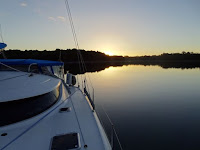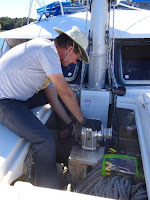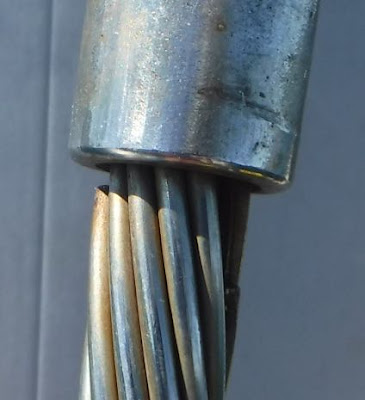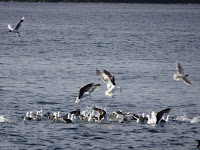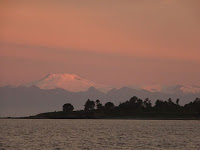[Kyle]We awoke to a lovely still morning and clear blue skies without a cloud in sight. Our plan was to spend the day on Mechuque, but since we had changed our plan and not anchored there, we instead rowed over to the main village on Añihue, to which we were technically closer. The scenery was typical tranquil waterway. The highlight of the row for me was when we disturbed a flock of about a hundred parrots. They were pretty swift, so I was never able to figure out if they were smallish macaws or largish parakeets. Either way, they were adorable and it's nice to see large groups of them in the wild.


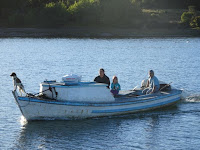



Rowing Ashore - headed for another church
we spy another steamer duck, but then Parrots!
At the town, such that it is, we found nothing going on. Both tiendas were shut and the small church had a ridiculously and what seemed unnecessarily stout padlock on the door. It was probably the sturdiest part of the whole structure. We found a couple of guys doing maintenance on their big fishing boat as it dried above the low tide line. Doing “yard” work on a boat is no fun, but theirs seemed to stretch for acres.






A typical local village
With nothing else to see, we took a road to see where it went. We found a sign for a restaurant, but no one was there. No people, anyway. We did meet the world's happiest dogs, two friends that chased each other from farm to farm, often breaking away to herd something. They would then come running over to us for a scratch and some validation from the new strangers before tumbling away in a multicolored ball, alternately tackling each other. What a life! They had the whole island on which to play.
Back at the dinghy, we decided to row over to Mechuque by going the long way around the intervening islet of Pelleullo. In the center, there was a large pasture occupied by cattle having a very lively discussion with each other. I imagine that it was a heated debate about the proper way for them to govern their society, but of course, I don't speak cow, so it could have been anything.






Enjoying a tour circumnavigating Pelleullo
(including a bit of wading)
More birds, including a steamer duck family and more penguins
It got a little shallow in the back, so we had to jettison some ballast to keep the Pudgy afloat in the falling tide, but we made it over. We rowed across to Mechuque and tied the dinghy to a fishing boat that was being painted.
We popped into the one of the local museums and had a look around at their rather interesting collection of household items. I imagined its origin could be traced to cleaning out somebody's over-full shed. In the museum was a map of every building in town, along with the names of the residents. I remarked to the caretaker surprise that there was a bridge in such a small town. She seemed amused by this. How could I not know about the bridge? Most tourists arrive on the ferry from Tenaun and have to walk over the bridge to get to the museum. We arrived by dinghy from the other side and stopped in because it was the second building we had encountered after stepping off the beach. I guess that's not the usual way.
After leaving the museum, we walked into the village and found the bridge just as the day's first load of ferry passengers found it from the other side. Now I got it. It is a pretty impressive bit of structure. Atop giant steel I-beams sits a wide wooden bridge. On top of that is an observation tower that was quickly filling with people who had beaten us to it from their end. The tide was still pretty low, so it spanned over an expanse of mud. It seemed a pretty disproportionate bit of architecture for a village of a few hundred to stay out of the mud, but it provided a great viewpoint for the palafitos on either side.








We explored Mechuque along with all the other tourists
After a couple more hours wandering around, we were feeling a bit peckish, so we decided to find somewhere to eat. There seemed to be better than average odds than we have been having on the islands lately of actually finding a place that was open. We spotted a place that looked reasonably busy, where we could see people sitting at tables behind the windows and headed over.
Every, one there seemed to be on some sort of organized tour. We were standing around trying to figure out how we could get a table or even if we could get a table, when we got swept up by a crowd being led by the owner toward some smoke. It seems as if we had arrived just by coincidence at the main event. It turns out all of the other tourists had been funneled into two or three local restaurants as part of their tours for the preparation of Curanto, Chiloe's traditional gastronomic bombshell.
We had passed over a description somewhere, but it is not prepared in too many places, so we never thought we would find it and moved on. Now we were suddenly front row for the big unveiling. Curanto is prepared in a Polynesian-style earth oven dug into the ground. Sizzling hot rocks are put in, topped with clams and mussels. A layer of nalca leaves (a local rhubarb) is put on top. Then comes a layer of pork, nalca, chicken, nalca, potatoes, nalca, bread and more nalca. The whole thing is then left to simmer for two hours or so.
The owner and cook pulled off layer after layer of leaves, releasing a cloud of smoke and steam, and set them aside. He then scooped up bowl after bowl of steaming food, which was whisked into the kitchen for plating. By the time he reached last of the shellfish at the bottom, it was getting difficult to scoop, so he just invited everyone to pluck one out for a taste from the remainder. I tried a clam, Maryanne had that and a mussel. It was so hot, I couldn't tell you anything about the flavor.


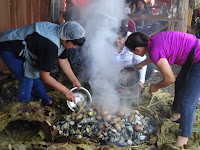





Yes! We found the traditional Curanto!
A bit too much meat for poor Kyle - but I made him smile for the camera!
After finishing his dig, the owner looked at us and realized we weren't with the larger group. He asked us to wait a bit and after a little confusion with some of the other staff, we were showed upstairs to a table. Before we could even ask for a menu, two piping hot plates of Curanto arrived and were placed before us. Whoops, make that three. The shellfish came in a separate bowl. So that settles that – Curanto for lunch, then. Each item is basically a meal in itself, so we had something like seven before each of us. Even though Curanto is pretty heavy on the meat, I managed to nibble and taste my way through enough of it to leave a little beyond full. The nalca seems to impart a really nice mesquite-like smoky flavor to everything.
Cards are generally only accepted in cities. We were running a little low on pesos and had just been to a luau in Hawaii, so we were a little worried about the bill. We had been prepared for sandwiches. Just in case, Maryanne came up with a backup plan of running like hell while I grab a bottle of dish soap and a brush and ask where's the big sink. I offered to do the running, but she insisted it would be better her way.
The bill turned out to be 18,000 pesos after we threw in a tip. That's fourteen meals (and two beers) for about $25. It looks like I would get to go home with Maryanne after all.
After their meals were finished, the others proceeded en masse, parade-style, to their ferry and the island was then promptly shut. We took a short walk along the beach to a section on the other side of the bay where two large wooden fishing boats were being built plank by plank by a crew of men based in an adjacent shipping container. Their work was marvelous and daunting and they smiled and waved thanks at our appreciation. Taking the road back, we found miniature versions being built in the yard at the nearest house, presumably to be used as tenders.


Some genuine, serious boat building ashore
We had wondered if there might be some concern about our presence after the last ferry had pulled away. There is a rooming house on the island and we saw four tents set up on the grass near the beach, so it must not be unheard of for non-residents to be around after hours. The campers on the beach seemed to get quite a bit of entertainment from watching us row and row and row away toward nothing in particular before rounding a far off corner. They didn't seem to know about the catamaran we left hidden there.




And we return to Begonia, enjoing the views and birds on the way,
and some fresh flowers for the cockpit

